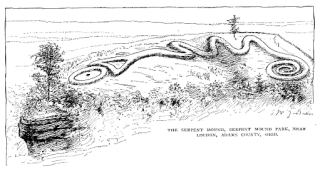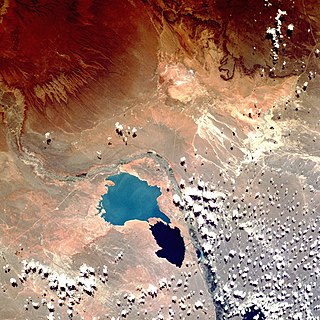| Huaco River | |
|---|---|
 | |
 | |
| Location | |
| Country | Argentina |
| Physical characteristics | |
| Length | 68 km (42 mi) |
The Huaco River is a river of Argentina.
| Huaco River | |
|---|---|
 | |
 | |
| Location | |
| Country | Argentina |
| Physical characteristics | |
| Length | 68 km (42 mi) |
The Huaco River is a river of Argentina.

In the classification of the archaeological cultures of North America, the Archaic period in North America, taken to last from around 8000 to 1000 BC in the sequence of North American pre-Columbian cultural stages, is a period defined by the archaic stage of cultural development. The Archaic stage is characterized by subsistence economies supported through the exploitation of nuts, seeds, and shellfish. As its ending is defined by the adoption of sedentary farming, this date can vary significantly across the Americas.
After an early flirtation with V-twin engines, Mazda's small cars of the 1960s were powered by OHV straight-2 and straight-4 engines. This family lasted from 1961 until the mid-1970s. Today, Mazda's keicars use Suzuki engines. It was produced at the Hiroshima Plant in Hiroshima, Japan.
Timex Sinclair was a joint venture established in December 1982 between the British company Sinclair Research and Timex Corporation in an effort to gain an entry into the rapidly growing early-1980s home computer market in North America.

The Guayquiraró River is a river in the Mesopotamic northeastern region of Argentina. It is born in the middle section of the border between the provinces of Entre Ríos and Corrientes, fed from several streams on its right-hand basin. It flows west along the interprovincial border for about 110 kilometres (68 mi), then emptying into the Paraná River, at a base level of about 26 metres (85 ft) AMSL.

The Cerros Colorados Complex is a group of dams and hydroelectricity generation facilities on the lower valley of the Neuquén River, in Neuquén, Argentina.
Cape Jeremy is a cape marking the east side of the north entrance to George VI Sound and the west end of a line dividing Graham Land and Palmer Land, Antarctica. It was discovered by the British Graham Land expedition, 1934–1937, under John Riddoch Rymill, who named it for Jeremy Scott, son of James Maurice Scott, who served as home agent for the expedition and was formerly a member of the British Arctic Air Route Expedition.
La Venta is a fossil locality located in the modern departments of Tolima and Huila in Colombia. This site is one of the richest Neogene fossil assemblages in South America and represents the best-known Cenozoic fossil site outside of Argentina. It provides a glimpse of what life in the region was like before the main wave of the Great American Interchange.

Comandante Luis Piedrabuena is a town with 4,175 inhabitants in the department of Corpen Aike in Santa Cruz province in Argentina.

Albardón is a department of the San Juan Province (Argentina). It is located in the center south of the same, which emphasizes a desert landscape with mountains and numerous plantations, highlighting the presence of prestigious wineries known nationally.

Chimbas is a department of the province of San Juan, Argentina. It is located on the south bank of the San Juan River, and is part of greater San Juan. The department is thoroughly urbanized and industrial.
Zonda Glacier is a glacier about 8 miles (13 km) long, flowing west-southwest between Fohn Bastion and Zonda Towers into George VI Sound. The glacier was included in surveys by Falkland Islands Dependencies Survey (FIDS), 1948, and British Antarctic Survey (BAS), 1971–72, and was photographed from the air by the U.S. Navy, 1966. The name applied by United Kingdom Antarctic Place-Names Committee (UK-APC) in 1977 continues the theme of wind names in the area, as "zonda wind" is the Argentine name for the warm dry wind descending the east slopes of the Andes.
The Barrancas River is a river in western Argentina. Traveling eastward from the Andes range, it separates the Argentine provinces of Mendoza and Neuquén. Joining the Río Grande, it merges into the Colorado, and flows into the Atlantic Ocean.

The Chico River is a river of Argentina.

Corpen Aike Department is a department in Santa Cruz Province, Argentina. It has an area of 26,350 km2. The seat of the department is in Puerto Santa Cruz. It borders the departments of Río Chico and Magallanes to the north, Lago Argentino to the west, and Güer Aike to the south, and has coastlines on the Atlantic Ocean to the east. It is traversed from west to east by the Santa Cruz and Chico rivers.
Choya is a village and municipality in the Andalgalá Department of Catamarca Province in northwestern Argentina. The town is located on National Route 47. It is located along the Río Choya.

Puerto Santa Cruz is a town and municipality in Santa Cruz Province in southern Argentina. It lies near the Atlantic coast on the northern bank of the estuary of Santa Cruz River. It is the second oldest city in the province, being founded in 1878. It was the capital of the Santa Cruz National Territory until Río Gallegos took over the position in 1888. The town is a local centre for sheep and cattle farming. The presence of fresh water in an otherwise semi-arid environment allows for orchards and a local horticulture.

Clemente Onelli is a village and municipality in Río Negro Province, in Argentina. It is located in the Veinticinco de Mayo Department, some 50 kilometers west from Ingeniero Jacobacci. As of 2010, it counted with 114 inhabitants.

Bills Gulch is a glacier on the southeast side of Hemimont Plateau, the northern of two glaciers flowing east from the plateau upland into the head of Trail Inlet, on the east coast of Graham Land. This glacier was used by the sledge party under Paul H. Knowles which traversed the Antarctic Peninsula from the East Base of the United States Antarctic Service (USAS) on its way to Hilton Inlet in 1940. It was named by USAS for a lead dog that died at this point. The unlikely name has been approved because of its wide use on maps and in reports.
The Smith & Wesson Model 3000 is a pump-action shotgun offered by Smith & Wesson during the 1970s and 1980s. The shotguns were manufactured in Japan by Howa Machinery.
30°18′00″S68°06′00″W / 30.3000°S 68.1000°W